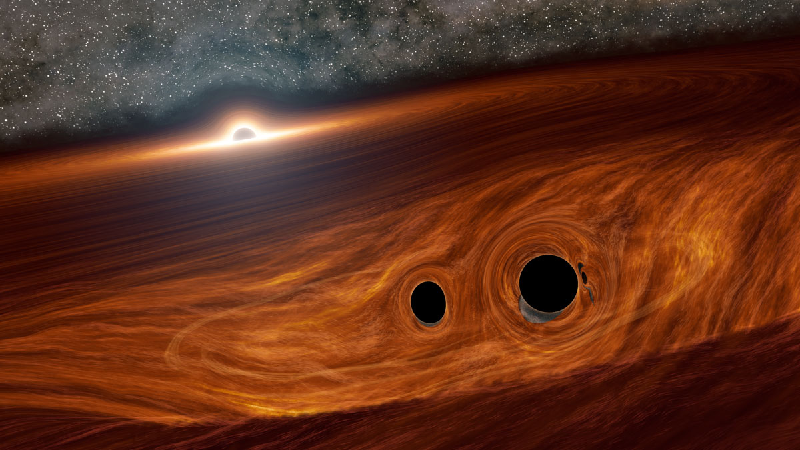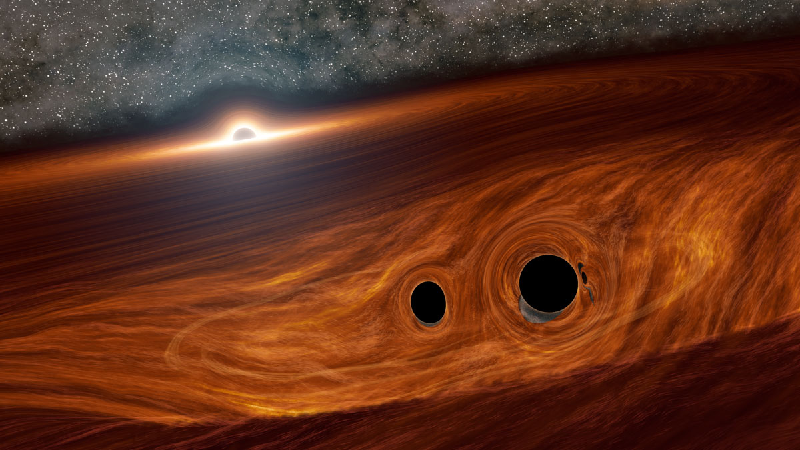Possible Flare from Black Hole Merger
On 21 May 2019, gravitational-wave detectors from the LIGO/Virgo collaboration picked up a possible signal from the merger of two black holes. That candidate event—which has yet to be confirmed—may be connected with a brightening, or flaring, of a distant quasar, according to an astronomical team. Based on this association, the team claims that the black hole merger occurred within the gaseous disk around the quasar. The researchers predict that the merged object—presumed to be a black hole having a record-breaking mass of roughly 150 times that of the Sun—will plunge back into the disk in a year or so, creating a second flare.
Big merger events can generate electromagnetic radiation, as evidenced by the 2017 neutron star merger that was seen by many observatories (see Viewpoint: Neutron Star Merger Seen and Heard). However, black holes are thought to merge in stellar graveyards where there is little gas or dust that can heat up and glow. “The expectation has always been that there would be no electromagnetic counterpart” to the merger’s gravitational-wave signal, says Matthew Graham from the California Institute of Technology, Pasadena.
But Graham and his colleagues have been working on an alternative model in which a black hole merger occurs in the more crowded environment of a quasar [1]—a bright object powered by a supermassive black hole having millions to billions of times the Sun’s mass. The light of a quasar comes from an accretion disk filled with hot gas and other material swirling into the black hole. If two stellar-sized black holes merge within the disk, they could stir up the gas and cause the quasar to briefly brighten.
To test this hypothesis, the team looked through archival data from the California-based Zwicky Transient Facility (ZTF), which identifies objects in the sky that rapidly change in brightness at visible wavelengths. They compared the ZTF catalog with 21 alerts put out by the LIGO/Virgo collaboration in 2019. Each of these alerts notifies astronomers about a potential gravitational-wave signal, including the source’s approximate coordinates. Through their analysis, Graham and his colleagues found a quasar flare that appeared in the same sky region as the 21 May candidate merger but delayed by 35 days. Quasars are known to vary in brightness, but the team showed that the observed flaring was inconsistent with past variations seen in this particular quasar’s emission. Graham and his colleagues also ruled out other possible explanations for the flaring, such as a supernova.
The team’s model explains this brightening as a merger of two black holes within the quasar accretion disk. According to the model, the resulting black hole shot out of the collision at high speed, creating a shock front that heated the gas along its path. The flare was delayed by several weeks relative to the gravitational-wave signal because the light was slowed by scattering in the opaque disk. At some point, the fast-moving black hole escaped the disk, which would explain why the flare ended after about 40 days.
The researchers predict that the black hole will orbit around the quasar’s central supermassive black hole and come crashing back into the disk approximately 1.6 years after the merger. Such a crash would reignite the flaring, which is why Graham and company plan to keep their eyes on this quasar for the next few years.
The LIGO/Virgo collaboration has not yet confirmed the type of event they detected. But Graham and his colleagues estimate that, if it was a merger, the merged black hole’s mass was around 150 solar masses, which would be the largest recorded so far. Such a large merger suggests that multiple, previous merger events built up the two black holes before their latest encounter. That kind of cumulative building could take place in a quasar disk, where many black holes may be concentrated (see Focus: Black Hole Assembly Line).
Astrophysicist Zoltan Haiman from Columbia University in New York says that the result is very significant if it can be confirmed. There are still some uncertainties, he says, such as whether a black hole merger could create a bright flare “before blowing the nearby gas to smithereens.” But if the quasar flares again within a year or so, as predicted, Haiman would have even more confidence in the model.
“The result suggests an exciting program of future observations [of quasars] that follow up on gravitational-wave candidates,” says LIGO Scientific Collaboration spokesperson Patrick Brady of the University of Wisconsin-Milwaukee. He looks forward to more electromagnetic counterpart detections as the rate of merger detections increases.
This research is published in Physical Review Letters.
–Michael Schirber
Michael Schirber is a Corresponding Editor for Physics Magazine based in Lyon, France.
References
- B. McKernan et al., “Ram-pressure stripping of a kicked Hill sphere: Prompt electromagnetic emission from the merger of stellar mass black holes in an AGN accretion disk,” Astrophys. J. 884, L50 (2019).





